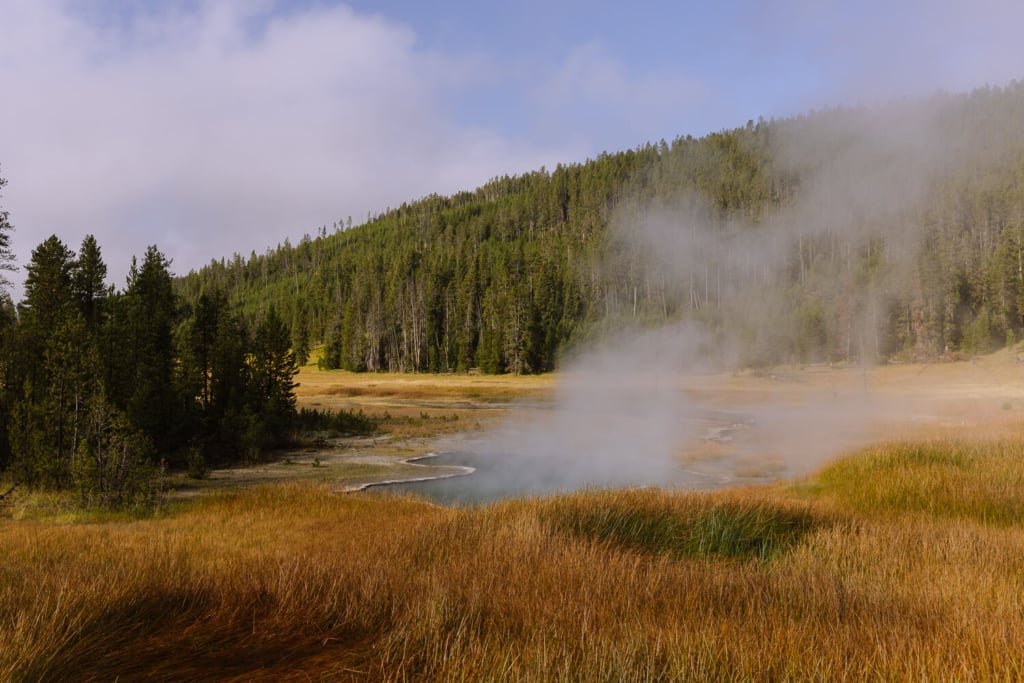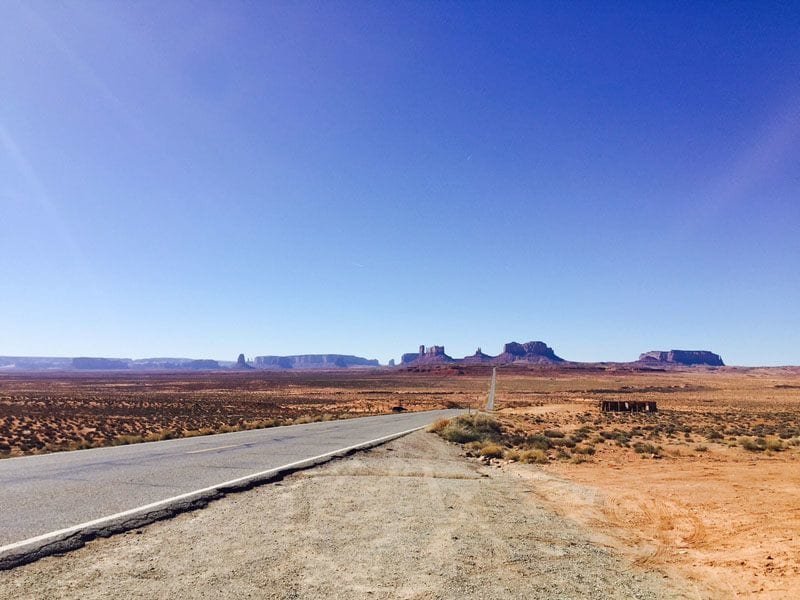Yellowstone is a super volcano. The world’s largest active volcano, it contains half the world’s hydrothermal features. Its most spectacular eruption was 640,000 years ago when a vast chunk of land collapsed and left a large depression in the earth – the Yellowstone Caldera.
In 1872 it became the first national park in the world, cementing the value of preserving such a valuable landmark. Alongside its geysers and bubbling mud-pots there are savannah-like landscapes and mighty canyons hosting the highest concentration of mammals anywhere in the contiguous United States.
The sheer size of Yellowstone, the overwhelming magnitude of the attractions, the array of outdoor adventures and the number of fascinating places to visit make Yellowstone a national treasure.
Our guide to the best things to do in Yellowstone National Park includes all the top attractions you won’t want to miss, the best places to visit as well as tips for getting the most out of Yellowstone National Park.
COMMENTS // We do our best to keep the information in this guide up to date, if you notice anything has changed, please leave a comment below.
BOOKINGS // Booking your trip via the links in this guide will earn us a small commission, at no extra cost to you. Thanks for your support – Paul & Mark.


1 – OLD FAITHFUL GEYSER
The most famous and most predictable of all the geysers in the park, Old Faithful is an unmissable attraction in Yellowstone. In a spectacular display, a plume of heated water is sent between 100 and 185 feet (30-56 metres) into the air.
Eruptions at Old Faithful are measured with impressive accuracy from one eruption to the next – the longer the eruption the longer the interval to the next.
Generally, eruptions take place anywhere between 60 to 110 minutes from each other – or around 20 times per day. Check the notice boards around the park for the next eruption time to help plan your visit.
WHERE TO WATCH OLD FAITHFUL
There are 3 great locations to see the eruptions at Old Faithful –
- The Boardwalk – Find a spot on the boardwalk surrounding the geyser and grab a ringside seat. This is the closest you can get to Old Faithful.
- Observation Point – Take the 1.1-mile (1.7 kilometres) round-trip up to Observation Point. This gives you an elevated view of the whole area.
- Old Faithful Inn – The outdoor terrace of the Old Faithful Inn gets you above the crowds, but is still quite close to the geyser. It’s a great viewing location.



2 – MORNING GLORY POOL & UPPER GEYSER BASIN
Morning Glory Pool is a hot spring around 30 minutes’ walk from Old Faithful. It’s remarkable for the distinct coloration caused by bacteria that inhabit the water, resembling the flower of the same name.
Although too small to be seen by the naked eye, trillions of microorganisms group themselves by water temperature creating a spiral of colors where blue is hotter and yellow is cooler.
The result is a brightly colored pool with rings of yellow at the edge progressing to brilliant green at the deepest part in the centre.

TOP TIP | WALK FROM OLD FAITHFUL TO MORNING GLORY
Morning Glory Pool is 1 mile from Old Faithful. We suggest you see an eruption at Old Faithful, then walk to Morning Glory Pool via the other geysers in the Upper Geyser Basin.
Make your way back to Old Faithful for another eruption, this time from a different viewpoint.
UPPER GEYSER BASIN
On the way to Morning Glory Pool, you can also explore the geysers of the Upper Geyser Basin, the largest concentration of geysers in the world. There are over 150 of these sprouting geothermal pools in one square mile.
The following geysers erupt at predictable intervals.
Castle Geyser // Castle Geyser contains a 12-foot-high cone that resembles a turreted crater. It erupts every 9 – 11 hours with a maximum height of between 60 and 90 feet.
Grand Geyser // Grand is often the tallest and most dramatic of the Geysers in the Upper Geyser Basin. It reaches a height of between 150 – 180 feet, however, at an interval of 8-12 hours it can be tricky to catch.
Daisy Geyser // Daisey erupts every 90 to 110 minutes to a height of between 60 and 75 feet with a duration of 3 to 4 minutes. There is a smaller geyser near Daisy called Comet which is pretty much constantly active, although small.
Riverside Geyser // Riverside is a picturesque geyser that erupts every 5 – 7 hours at a height of 75 feet. A pool of water above the geyser begins to overflow into the river around 1.5 hours before the eruption.




3 – BISCUIT BASIN & MYSTIC FALLS
Biscuit Basin is a collection of colorful thermal pools and small geysers located around 10 minutes’ drive from Old Faithful. It’s a great thing to do in Yellowstone with an accessible walkway around several cool thermal features.
The geysers and thermal pools are much smaller than those around Old Faithful, so you’re able to get much closer to them.
It originally received its name due to the biscuit-like formations on the edge of its largest crater, Sapphire. After an earthquake in 1959, an eruption at Sapphire disrupted the formations leaving the interesting geothermal features you see today.

Some of the highlights at Biscuit Basin include –
Rusty Geyser // A small geyser surrounded by a rusty-red basin that has a mini eruption every 2 to 3 minutes. The water temperature consistently above boiling could explain its frequent sprouting.
Jewel Geyser // Consistently erupting every 5 to 10 minutes, Jewel Geyser is named after the pearl-like beads which form around the vent. It’s one of the prettiest pools in Biscuit Basin.
Sapphire Pool // Sapphire Pool is named after its crystal-clear blue water with temperatures around 200°F (93°C). Since the earthquake that destroyed the biscuit-like crust, Sapphire boils and surges regularly but there are no eruptions.
MYSTIC FALLS WALK
After exploring the geothermal area, you could also hike to Mystic Falls, a 70-foot cascade in a small but rugged canyon. It’s an easy hike with around 320 feet of elevation that should be fine for most children over the age of 5.
The 2.4-mile (3.8-kilometre) hike over lovely forested trails is a unique thing to do in Yellowstone. The round trip should take just under 2 hours.



4 – GRAND PRISMATIC SPRING
The Grand Prismatic Spring is the largest hot spring in the USA and one of the most spectacular places to visit in Yellowstone.
The striking colors of the pool, matching those of a rainbow, are due to multiple layers of microorganisms around the edge of the mineral-rich water. Ranging from red to green on the edges, the centre is a brilliant blue due to the high temperatures, depth, and the fact that the water is sterile in the centre.
Hot water travels 121 feet from a crack in the earth to reach the surface of the spring. The vibrant colors, steaming atmosphere, and huge size makes Grand Prismatic Spring one of the most photographed locations in Yellowstone.



GRAND PRISMATIC SPRING OVERLOOK
The best view of Grand Prismatic Spring is from the overlook on the Fairy Falls Trail.
The path to the overlook is 1.2 miles (1.9 kilometres) and leaves from the Fairy Falls Trail Parking Lot. The trail is well-marked, has an elevation of 105 feet, and takes around 30 minutes (one way).
Fairy Falls Trailhead parking lot is around 1.3 miles from the Grand Prismatic Spring parking lot – about a 3-minute drive.

IMPORTANT | PARKING AT GRAND PRISMATIC & FAIRY FALLS
The parking lots at Grand Prismatic and Fairy Falls can both be very busy. If there are no spaces, you may be able to find somewhere on the side road and walk back, however, even these spaces fill up quickly.
The spring can often be shrouded in mist in the morning so it’s best to visit in the late afternoon.
5 – FOUNTAIN PAINT POT TRAIL
Fountain Paint Pot is another must-see geothermal area in Yellowstone. Named after the boiling mud pots in various shades of reds, yellows and browns, Fountain Paint Pot is accessible for people with all levels of ability via a 1/2 mile long circular loop over raised boardwalks.
While Fountain Paint Pot itself is an impressive mud pot with white bubbling mud surrounded by a pinkish-white dried crust, the highlight for us was Silex Spring.
The small pool in a brilliant shade of blue is framed with white silica and orange rippling edges.

THE YELLOWSTONE GRAND SLAM
One of the most interesting aspects of Fountain Paint Pot is that it contains all four of the geothermal features found in Yellowstone – mud pots, geysers, hot springs and fumaroles.
Here are some of the interesting geysers to spot on the circular boardwalk loop at Fountain Paint Pot.
Clepsydra Geyser // Almost constantly erupting, Clepsydra Geyser shoots to a height of around 45 feet.
Fountain Geyser // As the dominant member of the group at Fountain Paint Pots, Fountain Geyser erupts every 4 to 6 hours with a spray reaching up to 80 feet.
Morning Geyser // Morning Geyser is the largest geyser at Fountain Paint Pot with successive jets exploding up to 200 feet in the air and around the same wide. Unfortunately, the last major eruption was in 2013, with some smaller activity in 2018.



6 – FIREHOLE CANYON SWIM
Firehole Canyon Drive – a lovely 2-mile one-way road off the Grand Loop – takes you to a beautiful swimming area which is one of the most fun things to do in Yellowstone.
On the drive, stop off at Firehole Falls, a 40-foot waterfall surging through a thick lava flow that formed the canyon of the walls. There is a small parking area near the falls, and several pull offs along the road.
Just past the waterfall, there’s a wonderful swimming area in the Firehole River. Despite the name, the water is not hot, in fact, it’s decidedly fresh.
Access is via a set of wooden stairs that lead down to a rocky beach area. There’s plenty of room on the beach to laze around, even if you don’t intend to go for a swim.
Facilities at Firehole River Swimming – There is no parking lot at the swimming area, but there are generally places to park on the side of the road. There’s a small changing room at the top of the stairs, but no other facilities.
Opening times – The beach is closed during high water in Spring and in Winter. Check at any of the visitor centres in the park for dates that swimming is allowed on your visit.
UPDATE ABOUT BOILING RIVER SWIMMING
The only other possible swimming location in Yellowstone is Boiling River. A flood in June 2022, altered the mix of hot spring water and cold river water so that swimming is no longer possible. In addition, the boardwalks were washed away, and road access was cut off.
As a result, Boiling River is currently closed with no date yet available for when it will reopen.
 100vw, 900px” data-lazy-src=”https://anywhereweroam.com/wp-content/uploads/2023/01/firehole-canyon-swimming-3.jpg” /><figcaption class=) Firehole Canyon Falls
Firehole Canyon Falls 100vw, 900px” data-lazy-src=”https://anywhereweroam.com/wp-content/uploads/2023/01/firehole-canyon-swimming-1.jpg” /><figcaption class=) Firehole Canyon Swimming Spot
Firehole Canyon Swimming Spot 100vw, 1500px” data-lazy-src=”https://anywhereweroam.com/wp-content/uploads/2023/01/firehole-canyon-swimming-2.jpg” /><figcaption class=) Firehole Canyon swimming spot
Firehole Canyon swimming spot7 – STEAMBOAT GEYSIR AT NORRIS BASIN
Steamboat is the world’s tallest, currently active geyser and around eruption time it is one of the unmissable Yellowstone attractions.
Eruptions can last anywhere from 2 to 30 minutes where water is thrown more than 300 feet skyward. Curtains of water rush back down the slopes around Steamboat, dragging mud, sand, and rock back into the two vents to be shot back up into the air.
Trees have been dislodged and cars have been damaged during some of the more ferocious eruptions. The area surrounding Steamboat is a desolate landscape with dead trees, frozen in white from the spray.
 100vw, 1024px” data-lazy-src=”https://anywhereweroam.com/wp-content/uploads/2023/01/steamboat-yellowstone-1024×683.jpg” /><figcaption class=) Plume of steam 24 hours after a Steamboat eruption
Plume of steam 24 hours after a Steamboat eruptionUnfortunately, Steamboat is an unpredictable geyser. Recorded intervals between eruptions range from 3 days to 50 years. In 2020 there were around 48 eruptions, in 2021 around 19 and in 2022, there were 11.
On our visit, in 2021, it was erupting every 9 to 10 days.
TOP TIP | SEEING STEAMBOAT IN ACTION
Timing your visit for the eruption itself is difficult but for 24 hours after an eruption, there is a magnificent plume of surging steam which is well worth seeing.
If you hear (or see online) that Steamboat has erupted during your visit to Yellowstone, make your way there to see the steam aftermath.
 100vw, 1024px” data-lazy-src=”https://anywhereweroam.com/wp-content/uploads/2023/01/steamboat-yellowstone-2-1024×683.jpg” /><figcaption class=) Steamboat Geyser
Steamboat GeyserOTHER SITES AT NORRIS GEYSER BASIN
Norris Geyser Basin is the most volatile of all the geothermal areas in Yellowstone and it’s worth strolling around to explore the area washed in yellow and orange hues.
There are 2 main sections –
Porcelain Basin // Porcelain Basin is a barren landscape of hot springs and steaming vents in a colourful and compact space. There are no regular geysers, but it’s an interesting stroll over ground paths and raised boardwalks. The circuit is 0.75 miles (1.2 kilometres).
Back Basin // The Back Basin at Norris is a much larger area than Porcelain Basin with features spread across a partially wooded area. Don’t miss Emerald Springs, a beautiful green hot spring and Green Dragon Spring, a small pool partially covered in rock. Steamboat is also in the Back Basin. The circuit is 1.5 miles (2.4 kilometres).
 100vw, 1024px” data-lazy-src=”https://anywhereweroam.com/wp-content/uploads/2023/01/noris-basin-yellowstone-1024×683.jpg” /><figcaption class=) Porcelain Basin, Norris.
Porcelain Basin, Norris.8 – ROARING MOUNTAIN
Roaring Mountain is a thermal area containing several steam vents known as fumaroles which cascade up the side of the mountain.
As the hottest feature in Yellowstone, fumaroles have less water than hot springs or geysers, so the water is immediately converted to steam as it escapes.
The result is a mountain constantly smoking and hissing. Acid sulphate which also escapes from the vents has bleached the side of the mountain an eerie white.
Up until 1885, the fumaroles were much louder and more active, earning it the nickname Roaring Mountain.
The barren mountainside constantly shrouded in steam is an interesting stop on the Grand Loop Road.
Parking at Roaring Mountain – The pull-off is 5 miles north of the Norris Geyser Basin junction. There is generally plenty of parking, but as this is an overlook rather than a trailhead, if it’s full you should only need to wait around 5 minutes.
 100vw, 1024px” data-lazy-src=”https://anywhereweroam.com/wp-content/uploads/2023/01/roaring-mountain-yellowstone-1024×683.jpg” /><figcaption class=) Roaring Mountain
Roaring Mountain9 – MAMMOTH HOT SPRING TERRACES
The Mammoth Hot Springs is a series of travertine terraces with shallow pools cascading down walls colored by algae. Containing over 50 hot springs plus numerous gas vents and the remnants of dormant thermal features, it’s one of the most fascinating and scenic things to do in Yellowstone.
The terraces are viewed via two connected boardwalk loops.
FUN FACT | HOW ARE TRAVERTINE TERRACES FORMED?
Hot water rises through small fissures in the earth where it interacts with hot gases forming a compound called carbonic acid. The acid dissolves limestone on its way up through layers of rock which reforms as the white chalky mineral which is deposited as travertine.

LOWER TERRACE BOARDWALK
The Lower Terrace boardwalk is accessed from the Mammoth Hot Spring Terraces parking lot or the Grand Loop Road. The complete lower terrace loop is around 1 mile.
Some of the main features on the Lower Terrace are –
Liberty Cap // Liberty Cap is a 37-foot-high travertine cone formed when the now dormant hot spring had a continuous flow for around 100 years.
Minerva Spring // Minerva Spring is a large terrace with intricate travertine formations. It was completely dry until 1951 when the flow and color started returning.
Cleopatra Terrace // Cleopatra Terrace is a large orange and yellow mound, slightly off the trail near the edge of the forest.
Palette Spring // The most impressive feature at Mammoth Terraces, Palette Spring is a steep ridge of small pools and terraces with crisscrossing patterns in bright orange and brown.
 100vw, 900px” data-lazy-src=”https://anywhereweroam.com/wp-content/uploads/2023/01/mommoth-hot-spring-terraces-4.jpg” /></figure>
<figure class=)
 100vw, 900px” data-lazy-src=”https://anywhereweroam.com/wp-content/uploads/2023/01/mommoth-hot-spring-terraces-5.jpg” /></figure>
<figure class=)
 100vw, 1500px” data-lazy-src=”https://anywhereweroam.com/wp-content/uploads/2023/01/mommoth-hot-spring-terraces-6.jpg” /></figure><figcaption class=) Mammoth Hot Springs Terraces
Mammoth Hot Springs TerracesUPPER TERRACE
To visit the Upper Terrace, take the 1.5-mile Upper Terrace Drive which winds among several roadside hot springs before looping back. There is parking by the side of the road which offers access to the Upper Terraces without having to climb all the steps from the Lower Terraces.
Continuing along the loop be sure to stop at Orange Spring Mound, a huge travertine colored by algae and bacteria right by the side of the road.
 100vw, 900px” data-lazy-src=”https://anywhereweroam.com/wp-content/uploads/2023/01/mommoth-hot-spring-terraces-8.jpg” /></figure>
<figure class=)
 100vw, 900px” data-lazy-src=”https://anywhereweroam.com/wp-content/uploads/2023/01/mommoth-hot-spring-terraces-7.jpg” /><figcaption class=) Orange Spring Mound
Orange Spring Mound10 – LAMAR VALLEY
The great valleys of Yellowstone make an excellent habitat for wildlife. The Lamar Valley is one of the best places in the park to spot bears, elk, wolves, bison and several other species.
The Lamar Valley can get very busy during the day, so we’d recommend going just after sunrise or just before sunset. Wildlife spotting is best during these times, and the roads will be much quieter.
There are plenty of pull-offs along the valley floor to stop and spot wildlife. But you’ll most likely need to stop for bison who regularly cross the road in large herds.
One of the best places to look for wildlife in the Lamar Valley is Slough Creek Road, a 2-mile dirt road that ends at a camping spot. As an unpaved road it’s generally much quieter than the main roads in the valley.
How to get there – Lamar Valley is in the north of the park, around 1 hours’ drive from Mammoth Terraces. You’ll need at least 2 hours to drive through the valley and back again, more if you want to drive down Slough Creek Road.
 100vw, 1500px” data-lazy-src=”https://anywhereweroam.com/wp-content/uploads/2023/01/lamar-valley-yellowstone-3.jpg” /><figcaption class=) Bison in the Lamar Valley, Yellowstone
Bison in the Lamar Valley, Yellowstone 100vw, 1500px” data-lazy-src=”https://anywhereweroam.com/wp-content/uploads/2023/01/lamar-valley-yellowstone-2.jpg” /><figcaption class=) Pronghorn Deer in the Lamar Valley
Pronghorn Deer in the Lamar Valley 100vw, 1500px” data-lazy-src=”https://anywhereweroam.com/wp-content/uploads/2023/01/lamar-valley-yellowstone-1.jpg” /><figcaption class=) Bison in the Lamar Valley
Bison in the Lamar Valley11 – TOWER FALL
Located in the northeast of the park near Tower Junction, Tower Fall plunges 132 feet through a beautiful canyon of narrow spires.
Due to erosion, you can no longer walk to the bottom of the falls, however, a new parking lot and paved trail down to an overlook was built in 2021, making it an accessible attraction in Yellowstone. The path is around 150 yards from the parking lot.
You can also walk past the overlook point for around ¾ of a mile to see where the falls meet the Yellowstone River.

12 – DUNRAVEN PASS & MOUNT WASHBURN
The Dunraven Pass is a high mountain pass on the Grand Loop Road between Tower and Canyon that reaches a height of 8,800 feet (2,700 metres). It’s the highest pass in the park and a wonderful thing to do in Yellowstone to capture excellent views from the seat of your car.
When is the Dunraven Pass Open? The Dunraven Pass is usually open from May through to October. It is always the first to close in fall as Yellowstone begins to wind down for winter.
Is the Dunraven Pass difficult to drive? No. Dunraven is fully paved so it’s accessible in any type of vehicle.
MOUNT WASHBURN HIKE
The Dunraven Pass provides access to one of the best hikes in Yellowstone – the Mount Washburn hike.
The Mount Washburn trailhead is located next to the summit parking lot. From the Dunraven Pass Trailhead, ascend Mount Washburn for spectacular 360° views over the Yellowstone valleys.
Keep a lookout for bighorn sheep and beautiful wildflowers. It is also one of the best places in Yellowstone to spot grizzly bears who are often found looking for whitebark pine nuts in the fall. As a result of this activity, hiking is not recommended in September and October.
Distance – 6-mile return loop from the parking lot
Duration – 3 to 6 hours
Difficulty – Strenuous
Facilities – There is a washroom and observation deck at the overlook.

13 – GRAND CANYON OF YELLOWSTONE
The Grand Canyon of Yellowstone is the most breathtaking place to visit in Yellowstone National Park.
The burnt orange canyon, carved from the Yellowstone River contains one of the park’s most recognisable landscape, the Lower Falls. Framed by pastel colors and steaming vents in rocky walls, it’s a magical sight.
The canyon is 4,000 feet wide and 1,200 feet deep and there are several great vantage points on the South and North Rim.
 100vw, 1024px” data-lazy-src=”https://anywhereweroam.com/wp-content/uploads/2023/01/artist-point-yellowstone-1024×683.jpg” /><figcaption class=) Lower Falls from Artist Point, South Rim.
Lower Falls from Artist Point, South Rim.SOUTH RIM HIGHLIGHTS
Artists Point // This is the best place to be for sunrise in Yellowstone with the finest view of Lower Falls. Here you can capture the iconic photograph of the falls between the yellow canyon walls. It’s a short walk to the overlook from the large parking lot.
Upper Falls Viewpoint // Upper Falls Viewpoint is an easy walk to an overlook from the Uncle Tom’s trailhead with great views over the falls.
Uncle Tom’s Trail (CLOSED) // From the Upper Falls parking lot, 328 steps lead down to the base of Lower Falls. Unfortunately, the trail has been closed since 2019 with no information as to when it will reopen.
South Rim Trail // Follow the trail from Wapiti Lake Trailhead along the South Rim to Artist Point which clings to the canyon edge passing Upper Falls and Lower Falls. The trail is 2.4 miles (4 kilometres) one-way and takes around one hour.
South Rim + Clear Lake Loop // Extend the South Rim Trail (above) by returning via Clear Lake. The 5.1-mile loop has an elevation of 438 feet and visits Lily Pad Lake, Clear Lake and a geothermal area.

 100vw, 900px” data-lazy-src=”https://anywhereweroam.com/wp-content/uploads/2023/01/upper-falls-viewpoint.jpg” /><figcaption class=) Upper Falls Viewpoint
Upper Falls Viewpoint
NORTH RIM HIGHLIGHTS
The North Rim drive of the Yellowstone Grand Canyon collects the following viewpoints.
Brink of the lower falls // A steep ¾ mile downhill hike from the North Rim Drive parking lot that takes you to a viewing platform above the Lower Falls. It’s a short but strenuous hike using multiple switchbacks.
Lookout point // Lookout Point is an accessible overlook that provides one of the best views of the canyon and Lower Falls from the north rim. From the parking lot, it’s around ¼ mile to the lookout.
Red rock point // A ¾ mile trail that climbs down to one of the closest viewpoints of Lower Falls. The trail uses a combination of paved paths and wooden stairs to descend 260 feet.
Grand Viewpoint // An accessible viewpoint which is good for seeing the colors of the canyon and Yellowstone River. The falls are not visible from Grand Viewpoint.
Inspiration point // Inspiration Point accessible overlook with views both upstream and downstream of the Grand Canyon. It’s an easy hike from the parking lot, but the falls are not visible.


14 – HAYDEN VALLEY
The Hayden Valley is a vast open grassland – teeming with wildlife – centrally located within Yellowstone. Rolling hills, forested areas and the fertile valley make it a great destination for spotting bison, elk, bears, coyote and wolves.
There are several pull-offs along the road to stop and look for wildlife. It can be a busy area, so a good clue that there’s something worth stopping for is the number of cars crammed into a pull-out.
It’s more than likely that you’ll see a large herd of bison roaming through the valley, or even crossing the road.
The best time to spot wildlife is at dawn or dusk when the animals are most active.


















